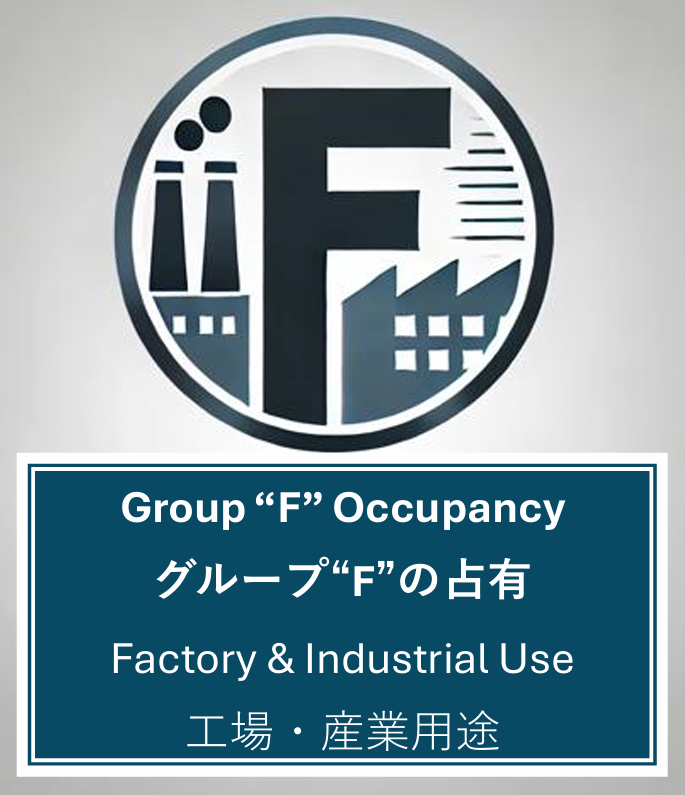
General Definition
- Factory & Industrial Group “F” Occupancy includes buildings used for manufacturing, processing, fabrication, assembly, or industrial operations that involve limited or moderate fire hazards, grouped under F-1 and F-2 occupancies.
- These facilities are regulated to ensure worker safety, fire protection, and proper ventilation.
- Both the International Building Code (IBC) and Japan’s Building Standard Law (BSL) categorize industrial buildings based on fire risks, materials handled, and process intensity, with BSL placing a stronger emphasis on seismic stability and environmental regulations.
- BSL does not subdivide industrial buildings (工業系 (Kōgyō-kei, Industrial Use) into low-hazard and moderate-hazard categories like the IBC but instead classifies them based on process type, fire risk, and location.
IBC Moderate-hazard factory industrial, Group F-1
- Aircraft (manufacturing, not to include repair)
- Appliances
- Athletic equipment
- Automobiles and other motor vehicles
- Bakeries
- Beverages: over 16-percent alcohol content
- Bicycles
- Boats
- Brooms or brushes
- Business machines
- Cameras and photo equipment
- Canvas or similar fabric
- Carpets and rugs (include cleaning)
- Clothing
- Construction and agricultural machinery
- Disinfectants
- Dry cleaning and dyeing
- Electric generation plants
- Electronics
- Engines (including rebuilding)
- Food processing establishments and commercial kitchens not associated with restaurants, cafeterias and similar dining facilities more than 2,500 square feet (232 m2) in area.
- Furniture
- Hemp products
- Jute products
- Laundries
- Leather products
- Machinery
- Metals
- Millwork (sash and door)
- Motion pictures and television filming (without spectators)
- Musical instruments
- Optical goods
- Paper mills or products
- Photographic film
- Plastic products
- Printing or publishing
- Recreational vehicles
- Refuse incineration
- Shoes
- Soaps and detergents
- Textiles
- Tobacco
- Trailers
- Upholstering
- Wood; distillation
- Woodworking (cabinet)
BSL Equivalents for IBC Group F-1
- 製造工場 (Seizō Kōjō) – General Manufacturing Plants: Factories involved in product fabrication, processing, or assembly.
- 自動車製造工場 (Jidōsha Seizō Kōjō) – Automotive Manufacturing: Facilities producing vehicles and major automotive components.
- 電子機器製造工場 (Denshi Kiki Seizō Kōjō) – Electronics Assembly Plants: Factories manufacturing and assembling electrical and electronic components.
- 機械製造工場 (Kikai Seizō Kōjō) – Machinery Manufacturing: Factories producing industrial machines and mechanical equipment.
- 酒類製造工場 (Shurui Seizō Kōjō) – Breweries & Distilleries: Facilities producing alcoholic beverages such as beer, wine, and spirits.
- パン工場 (Pan Kōjō) – Commercial Bakeries: Large-scale baking operations where ovens and combustible materials pose moderate hazards.
- 製薬工場 (Iyakuhin Seizō Kōjō) – Pharmaceutical Factories (Non-Hazardous): Factories producing medicine and medical products without hazardous chemicals.
- プラスチック製品工場 (Purasuchikku Seihin Kōjō) – Plastic Products Manufacturing: Factories producing plastic goods with moderate fire or material hazards.
Click the button below to access the applicable codes guidelines:
IBC Low-hazard factory industrial, Group F-2
- Beverages: up to and including 16-percent alcohol content
- Brick and masonry
- Ceramic products
- Foundries
- Glass products
- Gypsum
- Ice
- Metal products (fabrication and assembly
BSL Equivalents for IBC Group F-2
- 食品加工工場 (Shokuhin Kakō Kōjō) – Food Processing Plants (Non-Hazardous): Facilities involved in non-combustible food production and packaging.
- 乳製品加工工場 (Nyūseihin Kakō Kōjō) – Dairy Processing Plants: Factories processing milk and dairy products.
- 製氷工場 (Seihyō Kōjō) – Ice Production Plants: Facilities that manufacture ice products.
- 精錬所 (Seirenjo) – Metal Processing & Refining Plants: Facilities for metal refining, forging, and heat treatment.
- セメント工場 (Semento Kōjō) – Cement Plants: Factories producing cement and concrete products.
- ガラス製造工場 (Garasu Seizō Kōjō) – Glass Manufacturing: Factories involved in the production of glass and glass-based products.
- 組立工場 (Kumitate Kōjō) – Assembly Plants: Facilities focused on assembling products rather than manufacturing raw materials.
- 電子機器組立工場 (Denshi Kiki Kumitate Kōjō) – Electronic Device Assembly: Factories assembling consumer electronics, computers, and related components.
- 自動車部品組立工場 (Jidōsha Buhin Kumitate Kōjō) – Automobile Parts Assembly: Facilities assembling car parts rather than manufacturing vehicle components.
Click the button below to access the applicable codes guidelines:
Key Differences
- BSL has no direct F-1 or F-2 distinction but classifies factories by industry type and process risk.
- BSL regulates industrial zones more strictly than IBC, with specific districts for high-risk industries.
- Seismic design and environmental impact are more heavily emphasized in BSL industrial regulations.
